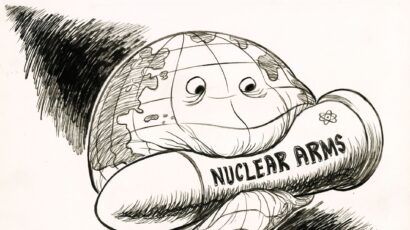Target Sochi: The threat from the Caucasus Emirate
By Charles P. Blair, Robert Straskulic | January 27, 2014
In less than two weeks, Russia’s southern resort city of Sochi will host the 2014 Winter Olympics. When the city was selected as an Olympic site, little attention was paid to Sochi's location on Russia’s western shore of the Black Sea, only a few hundred miles from the North Caucasus, a region teeming with anti-Russian jihadists seeking to create a global caliphate. Consisting of six vilayets, or provinces, organized under one umbrella, the Caucasus Emirate (CE) is arguably the most innovative, capable, and deadly terrorist organization active anywhere on the globe. The CE’s geographic proximity to Sochi lends credence to the group’s public declarations that bold attacks would occur during the forthcoming winter games.
While the Russian government has expressed confidence that the games will be devoid of disruption, several indicators highlight how seriously the Putin regime views the Caucasus Emirate threat, and what an embarrassment a successful attack would be. When compared to other Olympics, security for the Sochi games is unprecedented.
In the largest joint US- British security operation since World War II, the 2012 London Olympics was guarded by 12,000 police, with another 18,000 security personnel deployed or on standby. But this effort pales in comparison to the Russian security operation in Sochi, which will involve more than double the personnel attendant to the London Olympics. Backed by a series of sweeping laws and decrees allowing for unfettered surveillance, detainment, and control of public movement, 25,000 police, 8,000 elite security forces, and up to 30,000 regular soldiers will be deployed or on immediate standby. (The United States will even have two warships off the coast of Sochi "in case any Americans needed to be evacuated after a terrorist attack or other emergency,” a Pentagon official has said. Meanwhile, top US and Russian defense officials have discussed the sharing of technology to counter improvised explosive devices.) Such levels of security are likely to bring the cost of the Sochi Olympics in excess of $50 billion—by far the largest budget ever for an Olympics.
On the surface, it is difficult to imagine how an attack could even be attempted in an environment with such omnipresent security. But a number of factors suggest that the CE or another jihadist group in the area will attempt attacks during the Sochi Olympics. These attacks, if successful, could precipitate mass casualties and seriously damage the games, perhaps even halting them. The seriousness of the threat posed by the Caucasus Emirate is based on analysis of its history, its structure, its previous involvement in foreign attacks, and an extraordinary motive for striking at this time: The Sochi games coincide with two grim anniversaries of Russian atrocities against people in the North Caucasus.
Violence in the Caucasus. The history of violence that has defined the North Caucasus’ relationship with Moscow traces back to the 1770s, when Imperial Russia first expanded south into the region. Modern conceptions of unrest in the North Caucasus remain bound to Chechnya—one of the nine North Caucasus republics—and the two wars Chechen separatists fought after claiming independence following the 1991 demise of the Soviet Union. Rejecting the secession of the newly declared Chechen Republic of Ichkeriya, Russian forces began a brutal yet unsuccessful effort to reestablish control in 1994. By 1996, when Russian troops withdrew (temporarily giving Chechnya de facto independence), the ideology of the Chechen Republic had transformed from a nationalist struggle for independence to a religious struggle waged by local violent Islamists and foreign Salafi-jihadists. This profound ideological shift precipitated the establishment of jihadist camps that provided extensive training in guerrilla warfare and indoctrination into Salafi-jihadist ideology to scores of local and foreign fighters in the Chechen area.
Sensing an opportunity to create a new front for global jihad into Russia, Osama bin Laden began backing Chechen jihadists and other North Caucasus extremists in 1997. Emboldened by this logistical and motivational support, up to 2,000 rebels from Chechnya invaded the Russian Republic of Dagestan in 1999, with the goal of creating an independent Islamic state. This incursion precipitated the Second Chechen War, which ended when Russia defeated Chechen militants on the battlefield in May of 2000. Surviving leaders were unable to regroup until 2002, when the partially revived group expanded its operations in the Caucasus region and throughout Russia.
Significantly, after a prolonged internecine struggle, the Chechen Republic of Ichkeriya fully embraced jihadi ideology and Sharia-based order. With all vestiges of nationalist independence removed, the creation of an emirate—a political territory ruled by an emir—gained ascendency by 2006. Due to the deaths of its top three leaders and other setbacks, the group's operational capability declined. Consequently, as the Russian scholar and North Caucus jihadi expert Gordon M. Hahn explained during a series of interviews, “the situation was ripe for a re-branding under the increasingly popular banner of jihad.”
On October 29, 2007, the Caucasus Emirate officially supplanted the Chechen Republic of Ichkeriya. Dokku Umarov—often referred to as “Russia’s bin Laden”—became the CE’s self-appointed emir. The then-42-year-old Umarov was a veteran of many of the Chechen Republic of Ichkeriya's most notable attacks and regional battles. Beyond his operational experience, Umarov had also spent the previous year and a half as president of the secessionist, underground Chechen government. (Russia had restored federal control of the republic in 2000). Immediately declaring jihad against those states at war with “Muslims and Islam” (i.e., the United States, the United Kingdom, and Israel), Umarov expanded the Caucasus Emirate's operational capability through an effective combination of recruitment practices, the use of suicide bombers, and the execution of other, innovative types of attacks. Hahn observes in his forthcoming book, The Caucasus Emirate Mujahedin, that “the CE plugged itself into the core of the global jihadi revolutionary alliance, which lent it a resonant ideology, leadership cadres, weapons, [and] financial and propaganda resources.”
Thus, the Caucasus Emirate’s strategic goals, shaped by their jihadi ideology, far exceed those of the original Chechen insurgency; they play a seminal role in the jihadi revolutionary movement’s objective of a global caliphate. In 2010, a leading CE ideologue, Abu-t-Tanvir Kavkazkii, described the process of expanding the caliphate. After the liberation of the Caucasus, he explained, other regions, such as the Russian Ural Mountains, Western Siberia, and Central Asia (including Afghanistan and Pakistan) will be liberated. Moving westward, the Crimea region, “also a land occupied by non-believers,” will be released from the “infidel’s yoke.”
Following the liberation of Turkey, the emirate will ultimately link up with Salafi-jihadists in Syria.
Not your average terror group. All terrorist groups are not created equal; some have been able to outlast others, to innovate and adapt their tactics to changing ideological and political shifts better than others, and to accomplish their objectives more consistently than others. Clearly, the Chechen Republic of Ichkeriya and its successor, the Caucasus Emirate, are among the world's most effective terror organizations.
Fewer than three percent of terrorist groups have operated as long as the Chechen Republic of Ichkeriya, even fewer end by generating an even stronger organization. Since 1970, fewer than five percent of all terrorist attacks have generated more than 11 fatalities; Chechen insurgents perpetrated dozens of attacks exceeding that number of deaths—often greatly. Simultaneous attacks and successful assassinations are hallmarks of terror groups with high capabilities; the Chechen Republic of Ichkeriya has been among the elite in both categories.
No other terrorist organization is known to have more experience with radiological or “dirty bomb” materials. The Chechen Republic of Ichkeriya also explored chemical weapons and is widely believed to have reconnoitered Russian nuclear weapon storage facilities and transportation nodes, allegedly attempted to steal intact nuclear devices twice, and may have stolen “significant” amounts of plutonium.
The Caucasus Emirate inherited vast amounts of knowledge about generating high casualty counts, possesses innovative and highly complex operational capabilities, and has uncommon experience with unconventional weapons and their storage facilities. This inheritance has been used to devastating effect. According to Hahn, since the group's formation in October 2007, it has engaged in some 2,500 jihadi attacks and violent incidents, including 54 suicide bombings. In 2009, the CE killed a variety of high-ranking military and government officials in the North Caucasus. It also was involved in the unconventional and complicated task of detonating bombs buried beneath the Moscow-St. Petersburg Nevsky Express train attacks in the 2007 and 2009. The former attack injured 30; the latter attack generated 136 casualties.
In 2010, two Dagestani Caucasus Emirate “black widows” (the wives of Dagestani emirs fighting under the CE banner) detonated improvised explosive devices in the Moscow subway system, causing 135 casualties. In 2011, a Caucasus Emirate suicide bomber detonated himself inside Moscow's Domodedoyo Airport; the attack resulted in some 195 casualties. These explosive trends continued last year with the October and December Volgograd bus and train station bombings, which cumulatively resulted in more than 170 casualties. Although no group has claimed responsibility for the 2013 attacks, operatives in the bombings have Dagestani connections, heavily implying Caucasus Emirate involvement.
The histories of Chechnya, the Caucasus Emirate, and Sochi itself link the Winter Olympics eerily with two seminal and grim anniversaries. The date of the closing ceremonies of the Sochi Olympics, February 23, will also mark the 70-year anniversary of a vast deportation that remains vivid in Chechen culture. Feb. 23, 1944 is the day when the Soviet soldiers began carrying out Soviet leader Josef Stalin's order to deport nearly half a million Chechens and neighboring Ingushians from their homelands to Central Asia. Stalin feared the groups would collaborate with Nazi invaders. The death and dislocation associated with this event are seared into Chechen consciousness.
Eventually, the Chechens were at least allowed to return to their native land. This was not the case for Sochi’s ethnic Circassians, whom the Russian authorities simply killed in vast numbers—by some accounts, 600,000 lost their lives—in hundreds of raids over many decades of the 19th century. Some consider the operation to constitute the first genocide in modern Europe. Unrepentant, the Russian government still does not acknowledge the near total elimination of the Circassian population by the winter of 1864. This winter’s 150th anniversary of the mass killing is made all the more salient by a grisly fact: Many of the victims are buried beneath facilities and terrain in use for the Sochi Olympics.
Dagestan takes the lead. Since the Caucasus Emirate’s official formation in 2007, there has been a shift in the organization’s center of power. At the time of this writing, the Dagestan vilayet has earned the position as the most active, successful, and deadly of all six provincial CE organizations. According Hahn, the Dagestan group carried out 364 attacks resulting in an estimated 286 “infidel” deaths in 2012 alone. This level of death-dealing greatly outpaces the 53 attacks in Chechnya and 93 incidents in Ingushetia.
The ambition of the Dagestan vilayet can be seen in the complex and audacious attack it planned against the Eurovision 2012 music festival in Baku, Azerbaijan. Such an attack would have involved multiple car bombings around Baku, the assassination of Azerbaijani President Ilham Aliyev, and numerous additional attacks throughout the country. Even though Azeri security forces foiled the plot and arrested 40 suspects, an attempt of this scale demonstrates the DV’s ability to develop detailed and complex operation plans for targets outside Dagestan.
Other CE vilayets also present formidable threats to the Olympics.
Although the United vilayet of Kabardiya, Balkaria, and Karachai, which encompasses the regions of Kabardino-Balkaria and Karachayevo-Cherkessiya, has been relatively inactive with only 61 recorded attacks in 2012, one incident in particular stands out. In 2011, jihadists from this organization conducted a coordinated attack against tourists and facilities at the ski resort around Mount Elbrus in Kabardino-Balkaria, killing three and heavily damaging the resort’s cable car system. This attack is widely perceived as a potential trial run for an attack against the Sochi Olympic games and highlights how even relatively quiet vilayets can possess the operational capabilities and willingness to carry out ambitious and intricate attacks.
Beginning in 2010, Caucasus Emirate operations expanded into Europe and, possibly, the United States. In December 2010, Austrian officials intercepted a CE plot to attack a Belgian NATO facility. In April 2011, Czech counterterrorism officials uncovered a well-armed cell with links to the Dagestan vilayet in Bohemia. Spanish and French authorities arrested two Chechen extremists in August 2012 who, along with a Turk, were reportedly poised to begin an attack on a joint US-Spanish naval base in Rota, Spain or against targets in Gibraltar. According to Hahn the latter plan may have targeted “a Gibraltar shopping mall in an attack that was to be timed to occur during the London Olympic games.”
The three plotters reportedly were found with explosives, and, Hahn said, they "had been training on paragliders, and were preparing to bomb targets using paragliders or large toy planes or ‘drones.’”
Most recently, the Caucasus Emirate was linked to Tamerlan Tsarnaev, the elder of two brothers responsible for the April 15 Boston Marathon bombing that resulted in more than 260 casualties. Hahn contends that the CE’s involvement with Tamrlan Tsarnaev involved direct inspiration through operatives who met with him several times during his 2012 visit to Dagestan.
Many of the Caucasus Emirate’s fighters have gained experience or are currently fighting in Syria’s civil war. Indeed, there are now three major CE emirs working with two al-Qaeda affiliated groups in Syria: Jabhat al-Nusrah, or the Support Front for the People of the Levant, and ISIS (the Islamic State of Iraq and al-Sham). Before they publically split in April 2013, both groups originally entered the Syrian conflict under the banner of Al-Qaeda in Iraq—financed, in part, by Umarov, the so-called Russian bin Laden.
Two Caucasus Emirate emirs are active with Jabhat al-Nusra. Another CE emir is the military leader of ISIS’ entire northern front. “The CE fighters that are going from Russia to Syria go through Turkey,” Hahn explains, “and when they go back to Russia it is through Turkey.” The link between the CE and al-Qaeda affiliate groups in Syria has special meaning, given reports of Turkish police seizing significant quantities of sarin nerve gas from al-Qaeda-linked individuals.
The frightening possibilities. With the opening of the Sochi Olympics just days away, the ways in which Caucasus Emirate-related terrorism might impinge upon them seem to cluster around three general possibilities. The least likely would be a mass casualty attack in Sochi itself. Security is so high that an attack seems improbable. Still, it is a possibility. Insiders could have been planted in Sochi years ago. Moreover, two recent suicide attacks by the CE were conducted by female ethnic Russians working with handlers, also ethnic Russians, who might have an easier time getting into Sochi than terrorists of North Caucasus descent. Late in January of this year, Russian authorities were searching Sochi for a female revenge bomber, or "black widow."
But given the extraordinary security in Sochi, the most likely outcome would seem to be an attack elsewhere in Russia. The recent bombings in Volgograd—a major transportation hub for those traveling to Sochi—could portend another attack there. A successful attack anywhere in Russia would likely cast a pall over the games; the distance of an attack from Sochi and its perceived "success" in terms of casualties generated would seem to be the main factors that will determine how badly the games are damaged.
The CE could of course forego any attacks, using the Olympics as a way of gaining knowledge of Russian security practices ahead of other events that might be targeted, including the 2018 FIFA World Cup soccer tournament, to be held in 11 stadiums throughout Russia, including one in Sochi. But a Caucasus Emirate waiting game seems less likely than the possibility that terror attacks have been planned, and that the plans are ambitious. As William Faulkner famously wrote in 1951, "The past is never dead. It's not even past." The past that lives on in the minds of many in the Caucasus is a violent one, and for them, historic scores are just waiting to be settled.
Together, we make the world safer.
The Bulletin elevates expert voices above the noise. But as an independent nonprofit organization, our operations depend on the support of readers like you. Help us continue to deliver quality journalism that holds leaders accountable. Your support of our work at any level is important. In return, we promise our coverage will be understandable, influential, vigilant, solution-oriented, and fair-minded. Together we can make a difference.
















